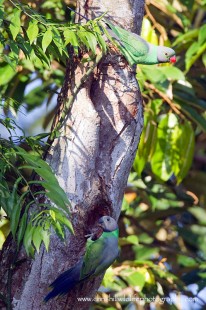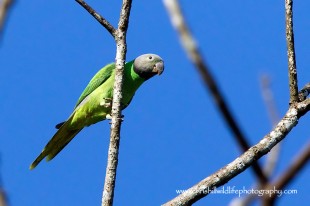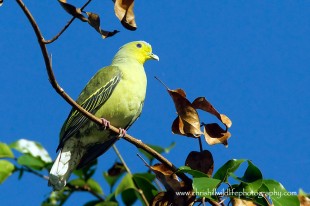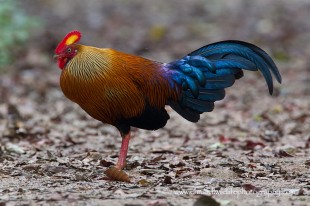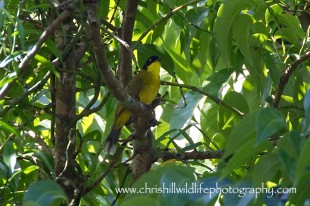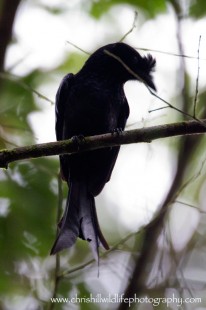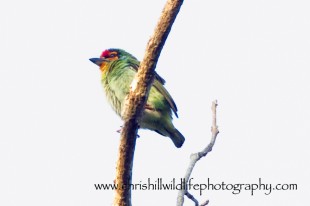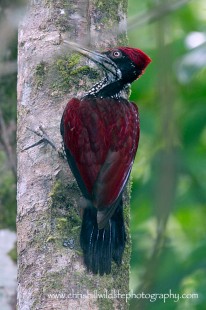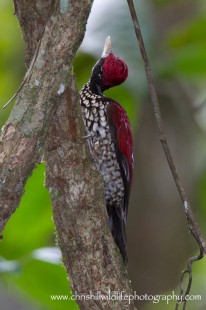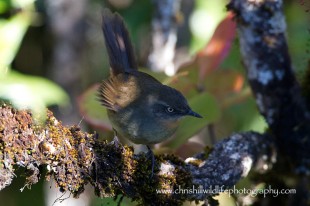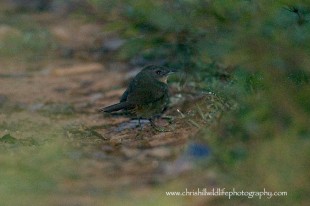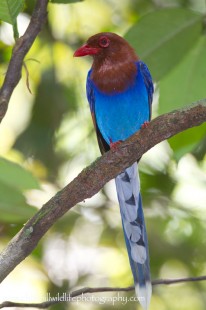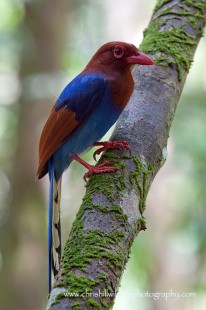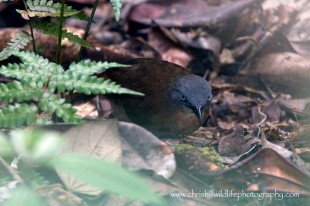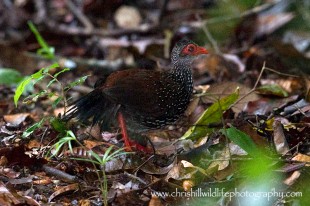
Sri Lanka is a popular destination for traveling birdwatchers with healthy population of endemic birds – up to 33 can be seen (the actual number varies depending on which classification system you want to use!).
During a two week visit in January /February 2013, our primary target was to see all 33 and then obviously try to photograph as many as possible. To that end, we were extremely successful – all 33 were seen and record shots were obtained of 32 of them. Here they are in order of when they were first seen and photographed:
(1) Sri Lanka Chestnut Backed Owlet – Kitulgala
This was the first endemic encountered on the trip, in the garden of a private residence near Kitulgala soon after dawn. Great views were obtained of a pair of owls which included them investigating a nest hole in a hollow coconut tree trunk.
This owl was only seen once at Kitulgala although it may also be encountered at Sinharajah.
(2) Sri Lanka Layard’s Parakeet – Kitulgala, Kandy and Sinharajah
Emerald-collared Parakeet, Sri Lanka Layard’s Parakeet, Calthorp’s Parakeet
The best views of the Layard’s Parakeets were obtained at Kitulgala, where a male and female were photographed on a nesting hole (below left – the male shows the red bill). These parakeets were often seen at the other sites but most frequently in flight or only briefly perched.
(3) Sri Lanka Hanging Parrot – Kitulgala and Sinharajah
Sri Lankan Hanging Parrot, Ceylon Hanging Parrot, Ceylon Hanging-Parrot, Ceylon Lorikeet, Sinhalese Hanging Parrot
This was the only endemic where no photograph was obtained at all. The majority of views were of the parrots shooting overhead and they were most frequently encountered at Kitulgala, although I wouldn’t describe them as common. Only one over flying parrot was seen at Sinharajah.
(4) Sri Lanka Green Pigeon – Kitulgala and Sinharajah
Pompadour Green-Pigeon, Pompadour Pigeon, Ceylon Green Pigeon
The Sri Lanka or Celyon Green Pigeons were relatively frequently seen at both of the forest sites. The photos below show the male (right) and female (left).
(5) Yellow Fronted Barbet – Kitulgala, Kandy, Dumbulla and Sinharajah
Sri Lanka Yellow-fronted Barbet, Yellow-faced Barbet
The Yellow Fronted Barbet was the most frequently encountered of the two endemic Barbets and was best seen at Kitulgala and Kandy.
(6) Orange Billed Babbler – Kitulgala and Sinharajah
Ceylon Babbler, Ceylon Jungle Babbler, Ceylon Rufous Babbler
It appeared to be less common and more shy than the Yellow Billed Babbler but was seen relatively often at the two forest sites. Along with the Sri Lanka Crested Drongos, the Orange Billed Babblers were often seen leading or in the forefront of the mixed feeding flocks in Sinharajah.
(7) Sri Lanka Grey Hornbill – Kitulgala and Sinharajah
Ceylon Grey Hornbill, Ceylon Gray-Hornbill
This hornbill was seen well at both Kitulgala and Sinharajah. Based on our experience, Kitulgala is probably an easier site for it as there were more mixed areas allowing more open views of the forest.
(8) Brown Capped Babbler – Kitulgala and Sinharajah
Brown-capped Jungle Babbler, Brown-capped Jungle-Babbler, Sri Lanka Babbler
This babbler was encountered at both sites although the best views were at Kitulgala. We didn’t try for it at Sinharajah but I image decent views could be obtained with a bit of effort if missed elsewhere.
(9) Ceylon Junglefowl – Kitulgala, Polonnaruwa, Yala and Sinharajah
La Fayette’s Junglefowl, Sri Lanka Jungle Fowl, Ceylon Jungle Fowl, La Fayette’s Jungle Fowl
This is probably one of the easiest and most conspicuous of the endemics, being easily seen at Yala and Sinharajah. In fact, a pair appear to patrol the main trail at Sinharajah, rushing up to visitors in search of an easy meal!
(10) Ceylon Swallow – Kitulgala, Sigirya, Sinharajah and around Colombo
Sri Lanka Swallow, Sykes’s Striated Swallow, Sykes’ Striated Swallow
Not as frequently encountered as the Barn Swallow but seen on several occasions during the trip and not uncommon.
(11) Black Capped Bulbul – Kitulgala and Sinharajah
Black-capped Yellow Bulbul, Black-headed Yellow Bulbul
Only seen on 3 occasions during the trip – twice at Kitulgala and once at Sinharajah – and could be overlooked.
(11) Ceylon Crested Drongo – Kitulgala and Sinharajah
Sri Lanka Drone
Only a fleeting glimpse at Kitulgala but common and conspicuous at Sinharajah – often leading or in the front of the mixed feeding flocks.
(12) Common Woodshrike – Sigiriya and Yala NP
Sri Lanka Woodshrike, Ceylon Woodshrike
Lived up to its name in the right habitat – was particularly widespread and common around Yala and Tissa.
(14) Red Fronted Barbet – Dambulla, Kandy and Sinharajah
Small Barbet, Crimson-fronted Barbet, Ceylon Small Barbet
Heard more often than seen but seen a few times on the trip.
(15) Crimson Backed Flameback – Kandy and Sinharajah
Crimson-backed Woodpecker, Crimson-backed Goldenback
Seen once at both sites and not common.
(16) Ceylon Scimitar Babbler – Kandy, Horton Plains and Sinharajah
Sri Lanka Scimitar-babbler
Proved a difficult species to get good views of and photograph although was often heard. Always moving quickly through the top of the canopy.
(17) Sri Lanka Dull Blue Flycatcher – Nuwara Eliya and Horton Plains
Dusky Blue Flycatcher, Sri Lanka Dusky Blue Flycatcher, Sri Lankan Dusky Blue Flycatcher, Sri Lanka Flycatcher, Sri Lanka Dull Blue Flycatcher, Ceylon Dusky Blue Flycatcher, Ceylon Blue Flycatcher, Ceylon Flycatcher, Dull Verditer Flycatcher, Oriental Dusky Blue Flycatcher, Oriental Dusky Flycatcher, Oriental Flycatcher, Sordid Flycatcher
Only seen at the higher elevations but fairly common in the right areas.
(18) Sri Lanka White Eye – Nuwara Eliya and Horton Plains
Sri Lanka Hill White-eye, Hill White-eye, Ceylon Hill White-eye, Ceylon White-eye, Ceylon White Eye, Large Sri Lanka White-eye
Only seen at the higher elevations but common in the right areas.
(19) Sri Lanka Yellow Eared Bulbul – Nuwara Eliya and Horton Plains
Sri Lanka Yellow-eared Bulbul, Sri Lanka Bulbul, Ceylon Bulbul, Yellow-tufted Bulbul
Common at the higher elevations – particularly on Horton Plains.
(20) Sri Lanka Wood Pigeon – Nuwara Eliya and Horton Plains
Ceylon Wood Pigeon
Fairly common at the higher elevations but proved hard to obtain good views.
(21) Sri Lanka Bush Warbler – Horton Plains
Ceylon Bush Warbler, Palliser’s Bush-warbler, Palliser’s Warbler
Was frequently seen on Horton Plains but usually only glimpsed moving deep inside low bushes. One obliging individual was seen and photographed – the rest were impossible!
(22) Sri Lanka Whistling Thrush – Nuwara Eliya
Arrenga, Ceylon Arrenga, Ceylon Whistling-Thrush, Blyth’s Whistling Thrush
Along with the Green Billed Coucal, the Whistling Thrush proved to be one of the toughest birds for us – very shy and difficult to see. We tried for this on a number of occasions but it was finally seen on our last morning at Numara Eliya – our last chance for this species. Horton Plains is potentially the best site for this but the location of the entrance gate means that the window of opportunity around dawn to see this near the road is relatively small.
These photographs of a female were taken after a long predawn stakeout near Nuwara Eliya.
(23) Sri Lanka Myna – Sinharajah
Ceylon Myna, Ceylon Mynah, Ceylon Hill Myna, Ceylon Hill Mynah, Ceylon Grackle, Ceylon Grackle Mynah
Seen a few times around Martin’s Lodge at Sinharajah.
(24) Legge’s Flowerpecker – – Sinharajah
White-throated Flowerpecker
Relatively common around the forest edge in Sinharajah.
(25) Spot Winged Thrush – – Sinharajah
Spot-winged Ground Thrush, Sri Lanka Spot-winged Thrush, Spotted-winged Ground Thrush, Spotted-winged Thrush
I missed out on this at Kitulgula but this lovely bird was relatively conspicuous around Sinharajah – one individual was even a regular dawn visitor to Martin’s Lodge. Lovely song.
(26) Sri Lanka Blue Magpie – Kitulgala and Sinharajah
Sri Lanka Magpie, Ceylon Blue Magpie, Ceylon Magpie, Blue Magpie
A brief view at Kitulgala but very confiding at Sinharajah around Martin’s Lodge and the Research Station. Biggest challenge was fitting the whole bird in the shot!
(27) Red Faced Malkoha – Sinharajah
One of my personal key targets for the trip and it didnt disappoint. A striking bird which was seen a couple of times at Sinharajah as part of the mixed feeding flocks. Photographs show the male (left) and female (right) – Cuckoos of the World describes the male have more white and less black around the face than the female and states the iris color differs with the male’s being brown and the female white
(28) Green Billed Coucal – Sinharajah
Ceylon Coucal, Sri Lanka Green-billed Coucal
Almost our big bogey bird having missed out on it at Kitulgala. It was our key target there but we missed out on it both mornings despite it being our main focus. A quick and poor view was obtained at Sinharajah – slightly fortuitously as we were searching for the Scaly Thrush at the time!
(29) Ashy Headed Laughing Thrush – Sinharajah
Seen a few times as part of the mixed feeding flocks but initially hard to pick up and differentiate from the similar sized Orange Billed Babblers. Always low down or feeding on the ground.
(30) White Faced Starling – Sinharajah
White-headed Starling, Ceylon White-headed Starling, Ceylon White-headed Myna, Ceylon Starling, Sri Lanka White-headed Myna, Sri Lankan White-headed Starling, Sri Lankan Starling, Sri Lanka White-faced Starling
Pre-trip we thought this may be a tricky species but a few views were obtained of birds perched high up in dead trees. Did not appear to be part of the mixed feeding flocks we saw.
(31) Scaly Thrush – Sinharajah
Sri Lanka Scaly Thrush, Ceylon Scaly Thrush
I was starting to have fears of dipping out on this when it wasn’t showing in any of the regular spots known to the forest rangers. Fortunately we were able to devote a bit of time to look and finally picked it up near the Research Station. Once spotted, we watch it for nearly an hour and it soon became apparent why it was easy to overlook – during the time we were watching it, it did little more than move a few meters alternating between feeding for a few minutes, then resting / preening for longer periods. It also had a curious habit of taking a few paces then bobbing. The shots below were taken near the end when it finally came into the open for a brief period before it was chased off by a Ceylon Junglefowl.
(32) Serendib Scops Owl – Sinharajah
Only discovered in 2001 and with a global population estimated at only 250 birds, this is without a doubt the star bird in Sri Lanka.
There is one area within the Sinharajah Reserve where the owl is known to roost by the forest rangers but unfortunately that owl could not be found when we were there. However, the Forest Rangers were up at 4am on our last full day and managed to find and pinpoint another owl which they were then able to show us. This new site necessitated negotiating a near vertical 12 foot slope but the reward was well worth it. As was the 3 hour walk home in the pouring rain!
(33) Sri Lanka Spurfowl – Sinharajah
Ceylon Spurfowl
The last in the set was the Spurfowl – often heard but relatively hard to see. We had tried for it a couple of times on the previous days without success but our guide Upali appeared confident and we had half a morning to dedicate solely to the mission.
A decent downhill walk from Martin’s Place lead us to a known stakeout outside the reserve and we were quickly rewarded with a relatively confiding female (left). The light was appalling but a record shot was obtained when the spurfowl crossed the path. Then on our return walk up the hill, a male (right) was then encountered on the road!
Full trip report to follow…..



